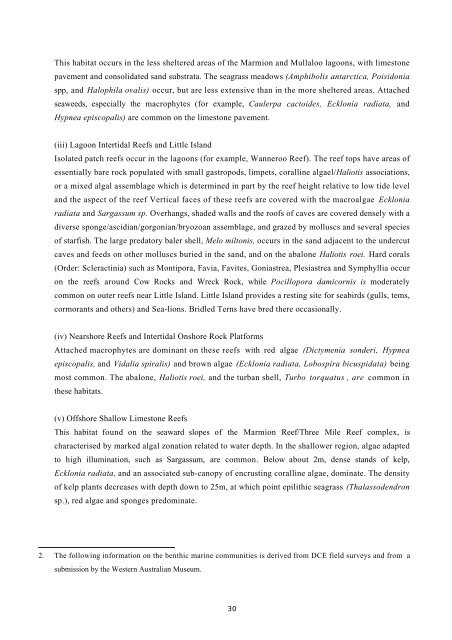Marmion Marine Park management Plan - Department of ...
Marmion Marine Park management Plan - Department of ...
Marmion Marine Park management Plan - Department of ...
- No tags were found...
Create successful ePaper yourself
Turn your PDF publications into a flip-book with our unique Google optimized e-Paper software.
This habitat occurs in the less sheltered areas <strong>of</strong> the <strong>Marmion</strong> and Mullaloo lagoons, with limestonepavement and consolidated sand substrata. The seagrass meadows (Amphibolis antarctica, Poisidoniaspp, and Halophila ovalis) occur, but are less extensive than in the more sheltered areas. Attachedseaweeds, especially the macrophytes (for example, Caulerpa cactoides, Ecklonia radiata, andHypnea episcopalis) are common on the limestone pavement.(iii) Lagoon Intertidal Reefs and Little IslandIsolated patch reefs occur in the lagoons (for example, Wanneroo Reef). The reef tops have areas <strong>of</strong>essentially bare rock populated with small gastropods, limpets, coralline algael/Haliotis associations,or a mixed algal assemblage which is determined in part by the reef height relative to low tide leveland the aspect <strong>of</strong> the reef Vertical faces <strong>of</strong> these reefs are covered with the macroalgae Eckloniaradiata and Sargassum sp. Overhangs, shaded walls and the ro<strong>of</strong>s <strong>of</strong> caves are covered densely with adiverse sponge/ascidian/gorgonian/bryozoan assemblage, and grazed by molluscs and several species<strong>of</strong> starfish. The large predatory baler shell, Melo miltonis, occurs in the sand adjacent to the undercutcaves and feeds on other molluscs buried in the sand, and on the abalone Haliotis roei. Hard corals(Order: Scleractinia) such as Montipora, Favia, Favites, Goniastrea, Plesiastrea and Symphyllia occuron the reefs around Cow Rocks and Wreck Rock, while Pocillopora damicornis is moderatelycommon on outer reefs near Little Island. Little Island provides a resting site for seabirds (gulls, tems,cormorants and others) and Sea-lions. Bridled Terns have bred there occasionally.(iv) Nearshore Reefs and Intertidal Onshore Rock PlatformsAttached macrophytes are dominant on these reefs with red algae (Dictymenia sonderi, Hypneaepiscopalis, and Vidalia spiralis) and brown algae (Ecklonia radiata, Lobospira bicuspidata) beingmost common. The abalone, Haliotis roei, and the turban shell, Turbo torquatus , are common inthese habitats.(v) Offshore Shallow Limestone ReefsThis habitat found on the seaward slopes <strong>of</strong> the <strong>Marmion</strong> Reef/Three Mile Reef complex, ischaracterised by marked algal zonation related to water depth. In the shallower region, algae adaptedto high illumination, such as Sargassum, are common. Below about 2m, dense stands <strong>of</strong> kelp,Ecklonia radiata, and an associated sub-canopy <strong>of</strong> encrusting coralline algae, dominate. The density<strong>of</strong> kelp plants decreases with depth down to 25m, at which point epilithic seagrass (Thalassodendronsp.), red algae and sponges predominate.2. The following information on the benthic marine communities is derived from DCE field surveys and from asubmission by the Western Australian Museum.30
















